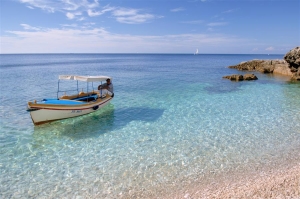Island of Ciovo
Ciovo is an island situated in middle Dalmatia, connected with the city Trogir by drawbridge, and administratively divided between Split, Trogir and Okrug.
Total surface of the island is 28,8 km2 and there are several villages: Okrug Donji (Lower,) Okrug Gornji (Upper), Arbanija, Slatine, Žedno and Ciovo. Čiovo is about 2 km away from the mainland on the east (cape Marjan); on the north-west, it is connected with mainland by drawbridge (in Trogir).
The island was inhabited already in prehistory and old Romans used to call it Boa (Bua, Bavo). During XV. and XVI. century the surrounding population came to the island, running away from the Turks. The south side of the island is rather uninhabited.
The Church of Our Lady of Prizidnica, with hermit facilities from 1546, situated among cliffs, lies on the southeast side of the island. The village Slatine is situated on the side of the island looking towards Split.
In the lagoon Supetarska, there was an old Croatian little church of St. Peter. Village Žedno is situated in the inland and there is the church of St. Maurice in the field, gathering place of hermits, and in the center of the village, there is the church of Bl. John of Trogir.
Arbanija is a village by the sea with Dominican convent of St. Cross, founded in XV. century. The monastery complex has cloister with the spacious garden, and quite interesting is the northern wall built like a fortress for better defense. In the church, there are also valuable paintings – heritage from the XVII. century.
In the village Čiovo there is also a Franciscan convent of St. Anthony, above the cave, former hermits’ dwelling, which has preserved its appearance from the XVII. century. The convent guards the crown made of gilted silver with jewels from XIV. century, sculpture St. Magdalene by Ivan Duknović, paintings of which the most valuable is the one made by Jacopo Palma the Younger from XVII. century.
Of smaller churches on Čiovo, there are the church of St. Nicholas (XIV. century), St. Andrew (VI./VII. century), St. Peter (XVI. century). Early Romanesque Church of Our Lady, situated by the sea, with Renaissance supplements, is built in memory of victory over inhabitants of Split. Okrug (Okruk) Upper and Okrug Lower, formerly part of Trogir, are today independent separated municipality with two churches, the church of St. Tudor and the church of St. Carlo Borromeo from 18th century.
Since the island Ciovo is a kind of extension of the city Trogir, it offers a lot of possibilities for vacation, recreation and swimming, as well as numerous historical monuments. The Mediterranean vegetation, archipelago with small picturesque little islands, mild climate and most beautiful beaches in hidden bays, will certainly make your stay unforgettable.
Čiovo’s position in the heart of Dalmatia makes it ideal starting point for exploring rich cultural heritage and natural beauties of Dalmatia. We wish you a hearty welcome to this beautiful island!
